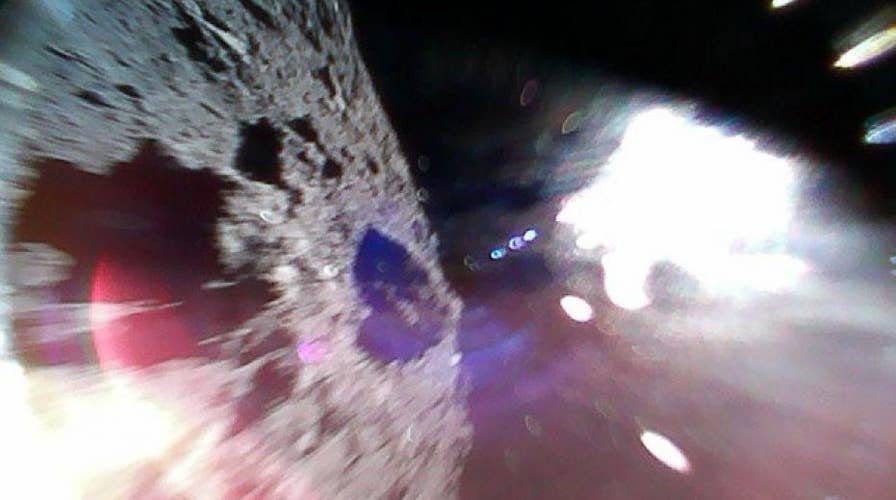History made: Japan lands robot on asteroid
A Japanese space agency’s spacecraft launched two rovers that took photos from an asteroid 170 million miles away from earth.
Japan’s space agency has released remarkable photos of a distant asteroid’s rocky surface that were captured by two small rovers.
On Friday, the Japan Aerospace Exploration Agency's (JAXA) Hayabusa 2 spacecraft lowered the MINERVA-II1 rovers onto space rock Ryugu.
Images released on Saturday show the surface of the “dumpling-shaped” asteroid, which has a diameter of just 2,953 feet.
JAPAN LOWERS ROVERS ONTO 'DUMPLING' ASTEROID, HOPEFUL OF HISTORIC TOUCHDOWN
The two rovers – Rover-1A and Rover-1B, are in good condition and transmitting images and data.

Image captured by Rover-1B on Sept. 21. This color image was taken immediately after separation from the spacecraft. The surface of Ryugu is in the lower right. The coloured blur in the top left is due to the reflection of sunlight when the image was taken. (Image credit: JAXA)
The rovers, each about the size of a cookie can, move by "hopping" up to 49 feet at a time because the extremely weak gravity on the asteroid makes rolling difficult. They can continue jumping as long as their solar panels and power last, JAXA said.
One color image captured in mid-hop by Rover-1A clearly shows the asteroid’s surface. Another image taken by Rover-1A that was captured immediately after separation from Hayabusa 2 also shows Ryugu’s rocky surface.
SPACE 'DUMPLING' RENDEZVOUS: JAPAN'S HAYABUSA 2 SPACECRAFT ARRIVES AT ASTEROID RYUGU
Hayabusa 2 spokesman Takashi Kubota said that he was thrilled to see the images. “The image taken by MINERVA-II1 during a hop allowed me to relax as a dream of many years came true,” he explained, in a statement. “I felt awed by what we had achieved in Japan. This is just a real charm of deep space exploration.”

Image captured by Rover-1A on Sept. 21. This is a color image taken immediately after separation from the spacecraft. Hayabusa2 is at the top and the surface of Ryugu is bottom. The image is blurred because the shot was taken while the rover was rotating. (Image credit: JAXA)
In addition to capturing images, the rovers measure surface temperatures. A larger rover and a lander will also be released from Hayabusa 2 as part of the mission. The mission’s MASCOT lander was developed by the German Aerospace Center (DLR) and the French space agency (CNES).
Hayabusa 2 is scheduled to attempt three brief touch-and-go landings on the asteroid to collect samples in hopes of providing clues to the origin of the solar system and life on Earth. Since it arrived at Ryugu, scientists have been looking for suitable landing sites on the uneven surface, and its first attempt is expected in October.
SPACE 'DUMPLING' LOOMS INTO VIEW AS SPACECRAFT PREPARES FOR ASTEROID RENDEZVOUS
Launched on Dec. 3, 2014, Hayabusa 2 arrived at Ryugu on June 27, 2018 when the asteroid was almost 170 million miles from Earth. The spacecraft traveled almost 2 billion miles to reach the space rock.
Hayabusa 2 is expected to leave Ryugu at the end of 2019 and return to Earth around the end of 2020.
The spacecraft is the successor to JAXA’s Hayabusa, which landed on asteroid Itokawa in November 2005. Despite being dogged with problems, the mission collected a number of asteroid samples, which returned to Earth with Hayabusa in June 2010.
AN ASTEROID TURNED INTO A BLAZING FIREBALL OVER AFRICA
NASA is also on a mission to retrieve an asteroid sample. The space agency’s OSIRIS-REx spacecraft launched on Sept. 8, 2016, from Cape Canaveral Air Force Station on a journey to near-Earth asteroid Bennu. OSIRIS-Rex is expected to arrive at Bennu on Dec. 3, 2018 and start surveying the space rock.
The spacecraft will return its asteroid sample to Earth in 2023.
The Associated Press contributed to this article.
Follow James Rogers on Twitter @jamesjrogers

